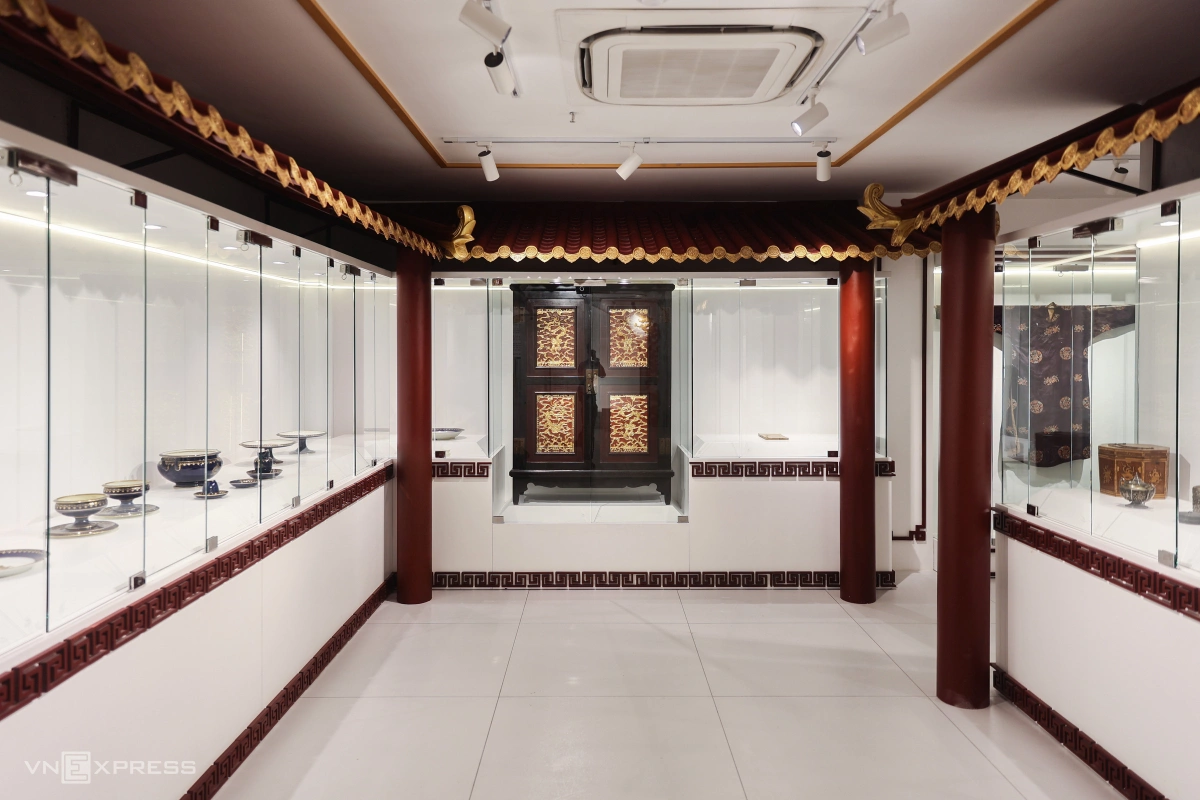Operating since early June, the Nguyen’s Royal Museum is located on the 8th and 9th floors of a building at 68 Nguyen Hue Street, displaying hundreds of Nguyen Dynasty (1802-1945) antiques.
The antiques belong to the collection of Do Hung - the founder of the museum. He said he opened this location to introduce to visitors artifacts collected over more than 30 years. "I want more people to know the traditional beauty through ancient artifacts, contributing to preserving the national essence," he said.
The inside of the museum is designed in the style of Hue royal architecture. The 8th-floor space displays antiques related to Nguyen kings such as Gia Long, Minh Mang, Tu Duc, Thanh Thai, and Khai Dinh. The 9th floor introduces themed forms of art, music, hobbies, and cuisine.
In the photo is an area displaying artifacts from the reign of King Khai Dinh (1916-1925) with dishes, chests, costumes, and books. In the middle is the 12th king's cabinet used by the Nguyen Dynasty.

Plates, bowls, and vases made of phap lam art, used in the Hue royal court, were crafted during the reign of Minh Mang (1820-1841) - the second king of the Nguyen Dynasty.
Phap lam is a type of art originating from the West that was modified and spread by Chinese craftsmen to neighboring countries, including Vietnam. In 1827, King Minh Mang ordered the Statue of the Phap lam Department - a department of the inner government specializing in making items for the royal court. Products include all types of household items, worship items, and interior and exterior architectural decorations of palaces.
Two paintings on mirrors date back to the reign of the third king of the Nguyen Dynasty - Thieu Tri (1841-1847).
According to Thai Van Kiem, author of the book Ancient Capital Hue, mirror paintings originated from China, were framed in gold-plated wooden frames, and were decorations only found in royal palaces.
Artifacts used in Thai Y Vien during the reign of Tu Duc (1847-1883), the 4th and longest-serving king in the 143-year history of the Nguyen Dynasty.
During the Nguyen Dynasty in Vietnam, there was an institution called Thai Y Vien dedicated to overseeing the healthcare of the king and the royal family. It was first established in the year 1802 under Emperor Gia Long, initially located in an area called Duong Sinh within the Imperial Citadel.
Later, during the reign of Emperor Minh Mang (1820-1841), Thai Y Vien was relocated to the eastern section of Duyet Thi Duong within the Imperial Citadel. This area housed administrative offices, residences, and other facilities as part of the royal palace complex.
The pen and gold medal of King Kien Phuc (1883-1884) given to the French deputy foreign minister at that time, accompanied by a translation into French. According to the museum, these artifacts are of high value because King Kien Phuc's reign was short and it is not easy to collect items related to him.
The trophy was placed in France in 1915 as a gift on the occasion of King Duy Tan's birthday (1907-1916). That year, the court placed two trophies made of gold-plated porcelain, inside decorated with the image of a five-clawed dragon - the symbol of the emperor's power and the court seal.
Hammocks for the princess (L) and prince, made of gold-plated wood. The hammock's two poles are decorated with a phoenix symbolizing the princess, and a qilin symbolizing the prince.
Set of dishes, chopsticks, and bowls in the display area of Nguyen Dynasty royal cuisine.
According to the book "An Nam customs" by Doan Trien (1854-1919), first-class banquets have 12 cups and 12 plates, the number gradually increasing with the size of the banquet. Food depends on the party and includes chicken, duck, and seafood, but pork and sticky rice are mandatory. In addition, alcohol is an important drink and must be freely consumed.
A set of toys called dau ho dating back to the reign of King Tu Duc (1847-1883) is on display. This is a game reserved for kings, regales, and feudal ministers, popular in many countries such as China, Japan, and Korea. "Dau" means to throw, "ho" means the vase, the player will throw the dart into the vase's mouth.
In Vietnam, this game was clearly recorded during the Nguyen Dynasty. Accordingly, King Tu Duc was a good player of this sport. King Bao Dai (1926-1945) also loved this game in addition to other sports such as archery, tennis, and badminton.
In addition to displaying Nguyen Dynasty artifacts, the museum also has a jewelry display area of 54 ethnic groups, open from 9 a.m. to 10 p.m. every day. Ticket price for both areas is VND450,000 ($17) per person, if visiting one area separately is VND250,000 ($9), free for children under 1 meter, currently discounted during the opening period.
The museum does not have parking space yet. Customers can park in lots around Nguyen Hue walking street.

















